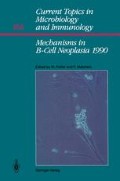Abstract
We and others have speculated that elevated expression of c-myc plays an important role in the establishment of the transformed follicle, a preneoplastic lesion essential for the development of the ALV-induced bursal-dependent lymphoma (Baba and Humphries 1985, Clurman and Hayward 1989, Neiman et al 1985). The discovery of base substitutions and missense mutations in some tumor c- myc alleles raises the possibility that qualitative as well as quantitative alterations within the chicken c-myc proto-oncogene may play a role in the genesis and/or progression of bursal lymphomas (Westaway et al 1984). In order to assess the contribution that deregulated expression of an unaltered c-myc allele makes during ALV lymphomagenesis (Hayward et al 1981) , we have constructed a recombinant avian retrovirus, SNVc-myc, that encodes the second and third exons of normal chicken c-myc and expresses only the smaller of the two c-myc proto-oncogene products, pp62c-myc and pp59c-myc (Hann et al 1988). Ultimately, this virus will enable the effects of specific mutations within the context of wild-type pp59c-myc to be assessed.
Access this chapter
Tax calculation will be finalised at checkout
Purchases are for personal use only
Preview
Unable to display preview. Download preview PDF.
References
Adams JM, Harris AV, Pinkert CA, Corcoran LM, Alexander WS, Cory S, Palmieri RD and Brinster RL (1985) The c-myc oncogene driven by immunoglobulin enhancers induced lymphoid malignancy in transgenic mice. Nature 318:533–538
Baba TW and Humphries EH (1985) Formation of a transformed follicle is necessary but not sufficient for development of an avian leukosis virus-induced lymphoma. Proc Natl Acad Sci USA 82:213–216
Baumbach WR, Keath EJ and Cole MD (1986) A mouse c-myc retrovirus transforms established fibroblast lines in vitro and induces monocyte-macrophage tumors in vivo. J Virol 59:276–283
Bister K, Hayman MJ and Vogt PK (1977) Defectiveness of avian myelocytomatosis virus, MC29: Isolation of long term nonproducer cultures and analysis of virus specific polypeptide synthesis. Virology 82:431–448
Chen ISY, Mak TK, O’Rear JJ and Temin HM (1981) Characterization of reticuloendotheliosis virus Strain T DNA and isolation of a novel variant of reticuloendotheliosis virus Strain T by molecular cloning. J Virol 40:800–811
Clurman BE and Hayward WS (1989) Multiple proto-oncogene activations in avian leukosis virus-induced lymphomas: Evidence for stage-specific events. Mol Cell Biol 9:2657–2664
Dotto GP, Parada LF and Weinberg RA (1985) Specific growth response of ras-transformed embryo fibroblasts to tumor promoters. Nature 318:472–475.
Hann SR, King MW, Bentley DL, Anderson CW and Eisenmann RN (1988) A non-AUG translational initiation in c-myc exon 1 generates a N-terminally distinct protein whose synthesis is disrupted in Burkitt’s Lymphomas. Cell 52:185–195
Hayward WS, Neel BG, and Astrin SM (1981) Activation of a cellular one gene by promoter insertion. Nature 290:475–480
La Rocca SA, Grossi M, Falcone G, Alema S and Tato F (1989) Interaction with normal cells suppresses the transformed phenotype of v-myc-transformed quail muscle cells. Cell 58:123–131
Martin P, Henry C, Ferre F, Duterque-Coquillaud M, Lagrou C, Ghysdael J, Debuire B, Stehelin D and Saule S (1986) Transformation of quail embryo fibroblasts by a retrovirus carrying a normal human c-myc gene. Eur Mol Biol Org Jrnl 5:1529–1533
Neiman PE, Wolf C, Enrietto PJ and Cooper GM (1985) A retroviral myc gene induces preneoplastic transformation of lymphocytes in a bursal transplantation assay. Proc Natl Acad Sci USA 82:222–226
Ramsay G, Enrietto PJ, Graf T and Hayman MJ (1982) Recovery of myc-specific sequences by a partially transformation defective mutant of avian myelocytomatosis virus, MC29, correlates with the restoration of transforming activity. Proc Natl Acad Sci USA 79:6885–6889
Stoker MGP, Shearer M and O’Neill C (1966) Growth inhibition of polyoma transformed cells by contact with static normal fibroblasts. J Cell Sci 1:297–310
Vennstrom B, Sheiness D, Zabielski J and Bishop JM (1982) Isolation and characterization of c-myc, a cellular homologue of the oncogene (v-myc) of avian myelocytomatosis virus Strain 29. J Virol 42:773–779
Watanabe S and Temin HM (1983) Construction of a helper cell line for avian reticuloendotheliosis virus cloning vectors. Mol Cell Biol 3:2241–2249
Watson DK, Premkumar Reddy E, Duesberg PH and Papas TS (1983) Nucleotide sequence analysis of the chicken c-myc gene reveals homologous and unique coding regions by comparison with the transforming gene of avian myelocytomatosis virus MC29, Δgag-myc*. Proc Natl Acad Sci USA 80:2146–2150
Weiss RA (1970) The influence of normal cells on the proliferation of tumor cells in culture. Exp Cell Res 63:1–18
Westaway D, Payne G and Varmus HE (1984) Proviral deletions and oncogene base-substitutions in insertionally mutagenized c-myc alleles may contribute to the progression of avian bursal tumors. Proc Natl Acad Sci USA 81:843–847
Zhou R-P and Duesberg PH (1988) Myc proto-oncogene linked to retroviral promoter but not to enhancer, transforms embryo cells. Proc Natl Acad Sci USA 85:2924–2928
Author information
Authors and Affiliations
Editor information
Editors and Affiliations
Rights and permissions
Copyright information
© 1990 Springer-Verlag Berlin Heidelberg
About this chapter
Cite this chapter
Humphries, E.H., Filardo, E.J. (1990). The Transforming Activity of PP59C-MYCis Weaker Than That of v-myc . In: Potter, M., Melchers, F. (eds) Mechanisms in B-Cell Neoplasia 1990. Current Topics in Microbiology and Immunology, vol 166. Springer, Berlin, Heidelberg. https://doi.org/10.1007/978-3-642-75889-8_32
Download citation
DOI: https://doi.org/10.1007/978-3-642-75889-8_32
Publisher Name: Springer, Berlin, Heidelberg
Print ISBN: 978-3-642-75891-1
Online ISBN: 978-3-642-75889-8
eBook Packages: Springer Book Archive

